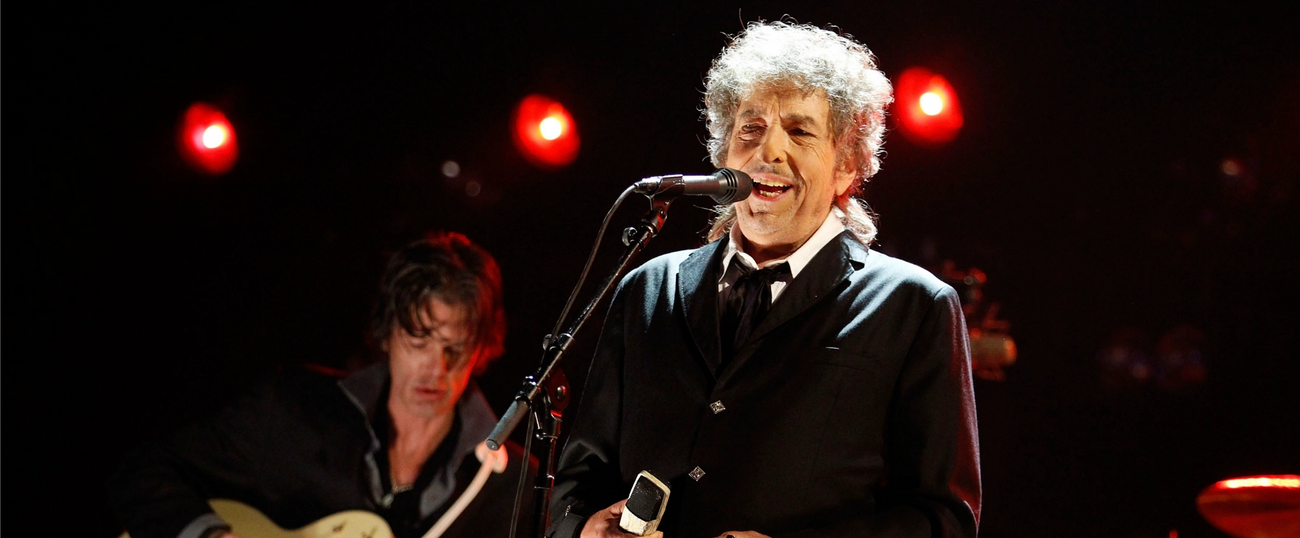Dylan Plays the Hits, But Not His Own
In March, Bob Dylan will release a triple album of covers of American songs




You Want it Darker, Leonard Cohen’s final album, was as bracingly adventurous as anything the songwriter recorded over the course of his five decades in music. Bob Dylan, that other shape-shifting late-20th-century Jewish musical icon, now offers a stark contrast. Cohen opened his last set by declaring himself ready to face death, which is about as existentially heavy as it gets. Dylan has his mind on more mundane matters, and he’s now recording some of the lightest stuff of his storied career.
Evidence of this begins, perhaps here, with the announcement this week Dylan will be releasing a triple album of covers in March, called Triplicate. It’s Dylan’s 38th studio album. His website put out a teaser a cover of “I Could Have Told You”—a heartbreak-themed Jimmy van Heusen song that Frank Sinatra recorded in 1953—played atop a video of a vinyl record lazily revolving in a turntable.
Since the mid-’90s, Dylan, with his legacy secure, has drifted further and further into the past. His last half-dozen albums since 1997’s Time out of Mind have been strange and brooding affairs, and they’re typically packed with songs that are too long and weird to hit heavy rotation. But the power and strangeness of the past two decades of Dylan’s work comes from how backward-facing a lot of it has been. “Someday Baby” from 2006’s Modern Times is virtually a cover of a Muddy Waters song. In instrumentation, structure, and melody, a song like “Spirit on the Water” from 2001’s Love and Theft recalls the country swing of the ’30s and ’40s, even if the song itself is a darkly psychological and death-obsessed reflection on a tortured romance. Dylan’s recent collaborators also recall an earlier period in American music: His creative partner for 2009’s Together Through Life was Robert Hunter, who is mostly known for writing the lyrics to nearly every good Grateful Dead song.
There were periods when Dylan was at the outer edges of what popular music could be and do: It’s still remarkable that a song as challenging as “Like A Rolling Stone” became as huge as it did, or that lyrics as inscrutable as “The kings of Tyrus with their convict list/ Are waiting in line for their geranium kiss” could appear on a double-platinum-selling album. Later on, and perhaps self-conscious about becoming a curio of the already distant-seeming 60s and 70s, Dylan appeared eager to be as of his time as possible: The synth and groove-heavy album Empire Burlesque sounds like it was made in 1985, because it was, in fact, made in 1985.
Thematic adventurousness grounded in formal conservatism became a comfortable middle-ground for Dylan, consistent with the broader sweep of his career: After all, his origin story involves visits to a dying Woody Guthrie in New Jersey. Dylan’s past several albums build upon his role as a vessel for neglected or forgotten aspects of the American folk tradition, as well as his status as someone uniquely capable of making that tradition breathe—proving it equal to modern anxieties, and showing how it could be just as expressive of our dilemmas as hipper or more contemporary cultural idioms. And the crazier the world gets, the more refreshing and reassuring the conservatism of a Modern Times or a Love and Theft becomes. These albums are all about the enduring power of American folk forms, and if even his latest music has few overtly Jewish themes, there’s still something recognizably Jewish about Dylan’s confidence in tradition and his headstrong commitment to finding meaning within it.
Still, over the past few years, Dylan’s work has become harder for even a Jewish-minded Dylanmaniac to love. In 2015 he released Shadows in the Night, an album of covers of songs that Frank Sinatra made famous. It’s interesting to hear Dylan reimagining the music of another American icon, and the project makes listeners think about the threads that run through both singers’ work. The album is also inessential—I suppose I’m glad to have a Dylan version of “Some Enchanted Evening,” but I didn’t need one. Fallen Angels, a second set of Sinatra covers released last year, was even less essential. Both albums made a little bit more sense to me during Dylan’s 2016 summer tour, where he interwove affecting Sinatra numbers like “In A Melancholy Mood” with late-period gems like 2009’s “Beyond Here Lies Nothing.” At its best, his touring set was a conversation between artists across time, with surprising moments of musical and thematic intersection. But at no point did I necessarily crave another three hours of just covers.
Dylan is 75 years old, and a Nobel Prize winner. It’s far from guaranteed that he’ll produce another album entirely consisting of original work (the last one was Tempest, which came out in 2012). And even if he does, he will have spent a significant chunk of his later career delving into a decades-old songbook that isn’t his, plumbing other people’s half-forgotten classics during a period of global upheaval. This isn’t a JD Salinger-like artistic vanishing act, exactly: Until Dylan came along, and even long after, folk musicians weren’t always expected to write their own music, and in a way, the cover albums return him to the preservationist roots of his art form. In a bleakly uncertain time, Triplicate could be a reminder of what makes Dylan so unique and vital. But it could also make fans wonder whether there isn’t something else he could be doing right now.
Armin Rosen is a staff writer for Tablet Magazine.